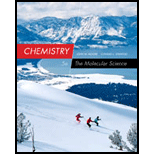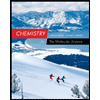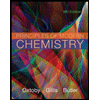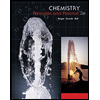
Chemistry: The Molecular Science
5th Edition
ISBN: 9781285199047
Author: John W. Moore, Conrad L. Stanitski
Publisher: Cengage Learning
expand_more
expand_more
format_list_bulleted
Question
Chapter 14, Problem 59QRT
(a)
Interpretation Introduction
Interpretation:
The
(b)
Interpretation Introduction
Interpretation:
The percent of the acid that has ionized in the solution has to be calculated.
Expert Solution & Answer
Want to see the full answer?
Check out a sample textbook solution
Students have asked these similar questions
A chemical engineer is studying the two reactions shown in the table below.
In each case, she fills a reaction vessel with some mixture of the reactants and products at a constant temperature of 70.0 °C and constant total pressure.
Then, she measures the reaction enthalpy AH and reaction entropy AS of the first reaction, and the reaction enthalpy AH and reaction free energy AG of the
second reaction. The results of her measurements are shown in the table.
Complete the table. That is, calculate AG for the first reaction and AS for the second. (Round your answer to zero decimal places.) Then, decide whether, under
the conditions the engineer has set up, the reaction is spontaneous, the reverse reaction is spontaneous, or neither forward nor reverse reaction is spontaneous
because the system is at equilibrium.
-
P₁ (s) + 20HF (g). 4PF, (g) + 10H2(g)
AH-1005. kJ
J
AS 2929.
K
AG =
0 kJ
Which is spontaneous?
this reaction
the reverse reaction
neither
AH = 12. kJ
+0=
AS =
SnO2 (s) + 2CO(g) →…
A chemist fills a reaction vessel with 0.281 g silver chromate (Ag₂CrO4) solid, 0.710 M silver (Ag*) aqueous solution, and 0.985 M chromate (CrO2-)
aqueous solution at a temperature of 25.0°C.
Under these conditions, calculate the reaction free energy AG for the following chemical reaction:
Ag2CrO4(s) 2Ag(aq) + CrO4(aq)
Use the thermodynamic information in the ALEKS Data tab. Round your answer to the nearest kilojoule.
4
☐ kJ
x
Draw the structure corresponding to each IUPAC name.
Part 1 of 2
A skeletal structure corresponding to the IUPAC name 3-ethylhexane.
Click and drag to start drawing a
structure.
Chapter 14 Solutions
Chemistry: The Molecular Science
Ch. 14.1 - Identify each molecule or ion as a Brnsted-Lowry...Ch. 14.1 - Using Le Chatelier’s Principle
Use Le Chatelier’s...Ch. 14.1 - Prob. 14.3ECh. 14.1 - Complete the table.
Ch. 14.1 - Prob. 14.4ECh. 14.1 - Prob. 14.5ECh. 14.2 - Prob. 14.6CECh. 14.2 - Prob. 14.7ECh. 14.3 - Prob. 14.2PSPCh. 14.3 - Prob. 14.3PSP
Ch. 14.4 - Calculate the pH of a 0.040-M NaOH solution.
Ch. 14.4 - In a hospital laboratory the pH of a bile sample...Ch. 14.4 - Prob. 14.8CECh. 14.4 - Prob. 14.9ECh. 14.4 - Prob. 14.10ECh. 14.5 - Write the ionization equation and ionization...Ch. 14.5 - Write the ionization equation and the Kb...Ch. 14.5 - Prob. 14.11CECh. 14.5 - Prob. 14.12CECh. 14.5 - Prob. 14.13ECh. 14.6 - Prob. 14.14CECh. 14.6 - Prob. 14.15CECh. 14.6 - Prob. 14.16CECh. 14.6 - Prob. 14.17CECh. 14.6 - Prob. 14.18CECh. 14.7 - Lactic acid is a monoprotic acid that occurs...Ch. 14.7 - Prob. 14.9PSPCh. 14.7 - Prob. 14.19ECh. 14.7 - Prob. 14.10PSPCh. 14.7 - Prob. 14.20ECh. 14.8 - Prob. 14.11PSPCh. 14.8 - Prob. 14.21CECh. 14.8 - Prob. 14.12PSPCh. 14.8 - Prob. 14.22ECh. 14.8 - Prob. 14.23CECh. 14.8 - Prob. 14.24CECh. 14.9 - Predict whether each of these is a Lewis acid or a...Ch. 14.9 - Prob. 14.26ECh. 14.9 - Prob. 14.27ECh. 14.10 - Prob. 14.28ECh. 14.10 - Prob. 14.13PSPCh. 14.10 - Prob. 14.29ECh. 14.10 -
Calculate the pH of 5.2-M aqueous sodium...Ch. 14 - Lactic acid, CH3CH(OH)COOH, is a weak monoprotic...Ch. 14 - Define a Brnsted-Lowry acid and a Brnsted-Lowry...Ch. 14 - Prob. 2QRTCh. 14 - Prob. 3QRTCh. 14 - Prob. 4QRTCh. 14 - Prob. 5QRTCh. 14 - Prob. 6QRTCh. 14 - Prob. 7QRTCh. 14 - Prob. 8QRTCh. 14 - Write a chemical equation to describe the proton...Ch. 14 - Write a chemical equation to describe the proton...Ch. 14 - Prob. 11QRTCh. 14 - Prob. 12QRTCh. 14 - Prob. 13QRTCh. 14 - Prob. 14QRTCh. 14 - Prob. 15QRTCh. 14 - Prob. 16QRTCh. 14 - Prob. 17QRTCh. 14 - Prob. 18QRTCh. 14 - Prob. 19QRTCh. 14 - Prob. 20QRTCh. 14 - Prob. 21QRTCh. 14 - Prob. 22QRTCh. 14 - Prob. 23QRTCh. 14 - Formic acid, HCOOH, is found in ants. Write a...Ch. 14 - Milk of magnesia, Mg(OH)2, has a pH of 10.5....Ch. 14 - A sample of coffee has a pH of 4.3. Calculate the...Ch. 14 - Calculate the pH of a solution that is 0.025-M in...Ch. 14 - Calculate the pH of a 0.0013-M solution of HNO3....Ch. 14 - Prob. 29QRTCh. 14 - Prob. 30QRTCh. 14 - A 1000.-mL solution of hydrochloric acid has a pH...Ch. 14 - Prob. 32QRTCh. 14 - Prob. 33QRTCh. 14 - Prob. 34QRTCh. 14 - Figure 14.3 shows the pH of some common solutions....Ch. 14 - Figure 14.3 shows the pH of some common solutions....Ch. 14 - The measured pH of a sample of seawater is 8.30....Ch. 14 - Prob. 38QRTCh. 14 - Valine is an amino acid with this Lewis structure:...Ch. 14 - Leucine is an amino acid with this Lewis...Ch. 14 - Prob. 41QRTCh. 14 - Prob. 42QRTCh. 14 - Prob. 43QRTCh. 14 - Prob. 44QRTCh. 14 - Prob. 45QRTCh. 14 - Prob. 46QRTCh. 14 - Prob. 47QRTCh. 14 - Prob. 48QRTCh. 14 - Prob. 49QRTCh. 14 - Prob. 50QRTCh. 14 - Prob. 51QRTCh. 14 - Prob. 52QRTCh. 14 - Prob. 53QRTCh. 14 - Prob. 54QRTCh. 14 -
A 0.015-M solution of cyanic acid has a pH of...Ch. 14 - Prob. 56QRTCh. 14 -
The pH of a 0.10-M solution of propanoic acid,...Ch. 14 - Prob. 58QRTCh. 14 - Prob. 59QRTCh. 14 - Prob. 60QRTCh. 14 - Prob. 61QRTCh. 14 - Amantadine, C10H15NH2, is a weak base used in the...Ch. 14 - Prob. 63QRTCh. 14 -
Lactic acid, C3H6O3, occurs in sour milk as a...Ch. 14 - Prob. 65QRTCh. 14 - Complete each of these reactions by filling in the...Ch. 14 - Complete each of these reactions by filling in the...Ch. 14 - Predict which of these acid-base reactions are...Ch. 14 - Predict which of these acid-base reactions are...Ch. 14 - Prob. 70QRTCh. 14 - Prob. 71QRTCh. 14 - Prob. 72QRTCh. 14 - Prob. 73QRTCh. 14 - Prob. 74QRTCh. 14 - Prob. 75QRTCh. 14 - Prob. 76QRTCh. 14 - Prob. 77QRTCh. 14 - Prob. 78QRTCh. 14 - Prob. 79QRTCh. 14 - Prob. 80QRTCh. 14 - Prob. 81QRTCh. 14 - Trimethylamine, (CH3)3N, reacts readily with...Ch. 14 - Prob. 83QRTCh. 14 - Prob. 84QRTCh. 14 - Prob. 85QRTCh. 14 - Prob. 86QRTCh. 14 - Common soap is made by reacting sodium carbonate...Ch. 14 - Prob. 88QRTCh. 14 - Prob. 89QRTCh. 14 - Prob. 90QRTCh. 14 - Prob. 91QRTCh. 14 - Prob. 92QRTCh. 14 - Prob. 93QRTCh. 14 -
Several acids and their respective equilibrium...Ch. 14 - Prob. 95QRTCh. 14 - Prob. 96QRTCh. 14 - Does the pH of the solution increase, decrease, or...Ch. 14 - Does the pH of the solution increase, decrease, or...Ch. 14 - Prob. 99QRTCh. 14 - Prob. 100QRTCh. 14 - Prob. 101QRTCh. 14 - Prob. 102QRTCh. 14 - Prob. 103QRTCh. 14 - Prob. 104QRTCh. 14 - Prob. 105QRTCh. 14 - Prob. 106QRTCh. 14 - When all the water is evaporated from a sodium...Ch. 14 - Prob. 108QRTCh. 14 - Prob. 109QRTCh. 14 - Prob. 110QRTCh. 14 - Prob. 111QRTCh. 14 - Prob. 112QRTCh. 14 - Prob. 113QRTCh. 14 - Prob. 114QRTCh. 14 - Prob. 115QRTCh. 14 - Prob. 116QRTCh. 14 - Home gardeners spread aluminum sulfate powder...Ch. 14 - Prob. 118QRTCh. 14 - Prob. 119QRTCh. 14 - Prob. 120QRTCh. 14 - Prob. 121QRTCh. 14 - Prob. 122QRTCh. 14 - Prob. 123QRTCh. 14 - Prob. 124QRTCh. 14 - Prob. 125QRTCh. 14 - A chilled carbonated beverage is opened and warmed...Ch. 14 - Prob. 127QRTCh. 14 -
Explain why BrNH2 is a weaker base than ammonia,...Ch. 14 - Prob. 129QRTCh. 14 - Prob. 130QRTCh. 14 - At 25 C, a 0.10% aqueous solution of adipic acid,...Ch. 14 - Prob. 132QRTCh. 14 - Prob. 133QRTCh. 14 - Prob. 134QRTCh. 14 - Prob. 135QRTCh. 14 - Prob. 14.ACPCh. 14 - Develop a set of rules by which you could predict...
Knowledge Booster
Learn more about
Need a deep-dive on the concept behind this application? Look no further. Learn more about this topic, chemistry and related others by exploring similar questions and additional content below.Similar questions
- Using any data you can find in the ALEKS Data resource, calculate the equilibrium constant K at 25.0 °C for the following reaction. TiC₁₁(g) + 2H₂O(g) → TiO2 (s) + 4HCl (g) 4 Round your answer to 2 significant digits. K = ☐ x10 D Хarrow_forward: ☐ Х Draw an α amino acid with a hydroxyethyl (-CH2-CH2- OH) side chain. Draw the molecule as it would appear at physiological pH. Click and drag to start drawing a structure. 5 Parrow_forwardDraw the product of the reaction shown below. Ignore inorganic byproducts. cat. H2SO4 HNO3 (1 equiv) Drawing Qarrow_forward
- Provide the correct systematic name for the compound shown here.arrow_forwardUsing the appropriate bond energies, calculate the heat of reaction AH for the following reaction: H-H + CI-CI 2 H-CI You can find a table of bond energies by using the Data button on the ALEKS toolbar. Round your answer to the nearest kJ/mol. Note: For clarity, all lone pairs have been omitted from the molecular structures. ☐ kJ mol ค 000 Ar Barrow_forwardPredict the hydrocarbon, of formula C6H10, needed to prepare the following geminal dibromide upon treatment with excess hydrobromic acid. Note: The shown product is the only regioisomer formed in this reaction. HBr H₂C. CH3arrow_forward
- A mixture of CaCO3 and MgC2O4 of unknown mass was heated in a 0.5 L closed rigid vessel to 900 degrees C.at 400C the following reaction occurs:MgC2O4 -> MgO (s) + CO (g) + CO2 (g)At 700C a second reaction occurs: CaCO3 -> CaO (s) + CO2 (g)The solid mass in the vessel was measured to be 3.06 g at 400C and 2.03g at 900CQuestion: What is the partial pressure of CO in both temperatures? (400 and 900C), provide detailed explanation.arrow_forwardFor the following alkyne, complete the reaction sequentially (that is draw the intermediate that we can’t stop at) and then name (complete name) all 3 molecules.arrow_forwardGiven the reaction sequence below, answer the following. A. Provide the structure for A. B. Provide the structure for B (pay attention to stereochemistry). C. Provide the structure for C. D. What are the stereochemical designations for I and II (R/S)?arrow_forward
arrow_back_ios
SEE MORE QUESTIONS
arrow_forward_ios
Recommended textbooks for you
 Chemistry: The Molecular ScienceChemistryISBN:9781285199047Author:John W. Moore, Conrad L. StanitskiPublisher:Cengage Learning
Chemistry: The Molecular ScienceChemistryISBN:9781285199047Author:John W. Moore, Conrad L. StanitskiPublisher:Cengage Learning Chemistry: Principles and ReactionsChemistryISBN:9781305079373Author:William L. Masterton, Cecile N. HurleyPublisher:Cengage Learning
Chemistry: Principles and ReactionsChemistryISBN:9781305079373Author:William L. Masterton, Cecile N. HurleyPublisher:Cengage Learning Principles of Modern ChemistryChemistryISBN:9781305079113Author:David W. Oxtoby, H. Pat Gillis, Laurie J. ButlerPublisher:Cengage Learning
Principles of Modern ChemistryChemistryISBN:9781305079113Author:David W. Oxtoby, H. Pat Gillis, Laurie J. ButlerPublisher:Cengage Learning Chemistry: Principles and PracticeChemistryISBN:9780534420123Author:Daniel L. Reger, Scott R. Goode, David W. Ball, Edward MercerPublisher:Cengage Learning
Chemistry: Principles and PracticeChemistryISBN:9780534420123Author:Daniel L. Reger, Scott R. Goode, David W. Ball, Edward MercerPublisher:Cengage Learning

Chemistry: The Molecular Science
Chemistry
ISBN:9781285199047
Author:John W. Moore, Conrad L. Stanitski
Publisher:Cengage Learning

Chemistry: Principles and Reactions
Chemistry
ISBN:9781305079373
Author:William L. Masterton, Cecile N. Hurley
Publisher:Cengage Learning

Principles of Modern Chemistry
Chemistry
ISBN:9781305079113
Author:David W. Oxtoby, H. Pat Gillis, Laurie J. Butler
Publisher:Cengage Learning

Chemistry: Principles and Practice
Chemistry
ISBN:9780534420123
Author:Daniel L. Reger, Scott R. Goode, David W. Ball, Edward Mercer
Publisher:Cengage Learning
Chemical Equilibria and Reaction Quotients; Author: Professor Dave Explains;https://www.youtube.com/watch?v=1GiZzCzmO5Q;License: Standard YouTube License, CC-BY